Business Communication Report: Information, Strategies, and Issues
VerifiedAdded on 2019/12/28
|10
|3017
|276
Report
AI Summary
This report provides a comprehensive overview of business communication, covering various aspects essential for effective information transfer within and outside an organization. It begins by defining business communication and then delves into different types of business information, their sources, and purposes, including transaction processing systems, management information systems, and decision support systems. The report further explores methods for presenting complex internal business information using presentations, short reports, and leaflets. Corporate communications, including responsibilities and employee relations, are also examined, alongside an evaluation of external corporate communications through advertising and public relations. Legal and ethical considerations related to business information use, such as the Data Protection Act, are discussed, followed by an analysis of operational issues like information security and organizational policies. Finally, the report outlines both electronic and non-electronic methods for communicating business information, providing examples for different audiences. The report emphasizes the importance of effective communication strategies for managing operations, building relationships, and ensuring business success.
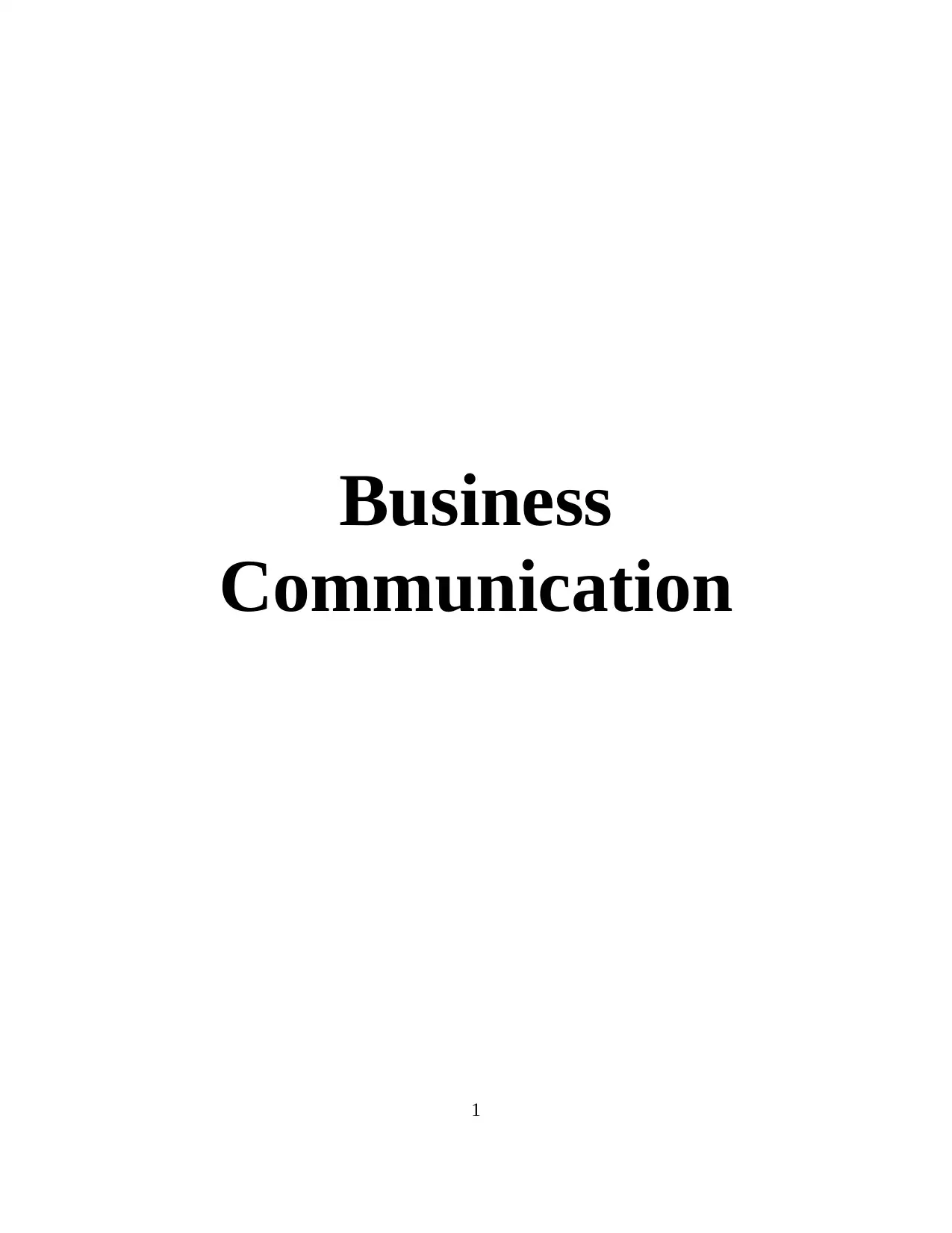
Business
Communication
1
Communication
1
Paraphrase This Document
Need a fresh take? Get an instant paraphrase of this document with our AI Paraphraser
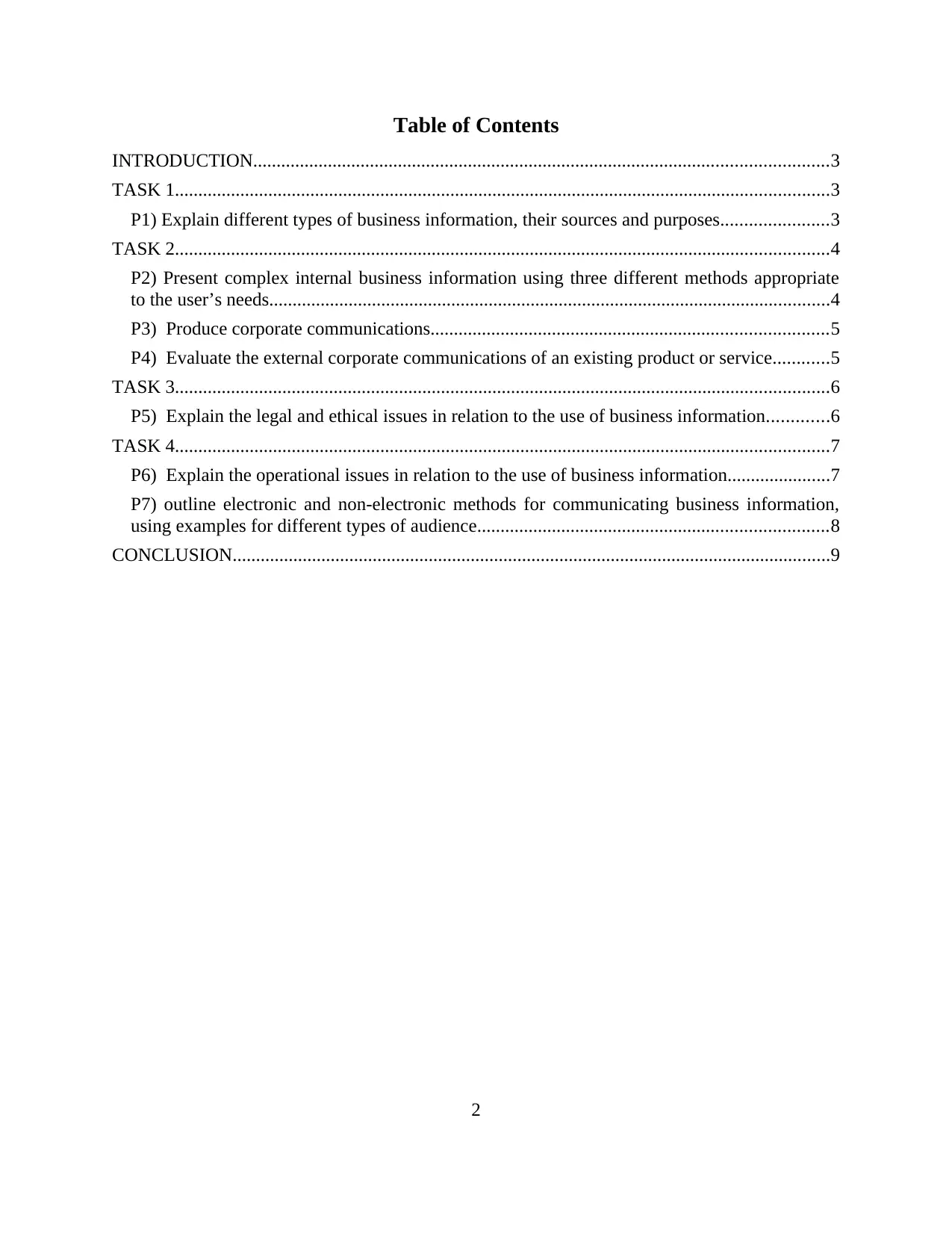
Table of Contents
INTRODUCTION...........................................................................................................................3
TASK 1............................................................................................................................................3
P1) Explain different types of business information, their sources and purposes.......................3
TASK 2............................................................................................................................................4
P2) Present complex internal business information using three different methods appropriate
to the user’s needs........................................................................................................................4
P3) Produce corporate communications.....................................................................................5
P4) Evaluate the external corporate communications of an existing product or service............5
TASK 3............................................................................................................................................6
P5) Explain the legal and ethical issues in relation to the use of business information.............6
TASK 4............................................................................................................................................7
P6) Explain the operational issues in relation to the use of business information......................7
P7) outline electronic and non-electronic methods for communicating business information,
using examples for different types of audience...........................................................................8
CONCLUSION................................................................................................................................9
2
INTRODUCTION...........................................................................................................................3
TASK 1............................................................................................................................................3
P1) Explain different types of business information, their sources and purposes.......................3
TASK 2............................................................................................................................................4
P2) Present complex internal business information using three different methods appropriate
to the user’s needs........................................................................................................................4
P3) Produce corporate communications.....................................................................................5
P4) Evaluate the external corporate communications of an existing product or service............5
TASK 3............................................................................................................................................6
P5) Explain the legal and ethical issues in relation to the use of business information.............6
TASK 4............................................................................................................................................7
P6) Explain the operational issues in relation to the use of business information......................7
P7) outline electronic and non-electronic methods for communicating business information,
using examples for different types of audience...........................................................................8
CONCLUSION................................................................................................................................9
2
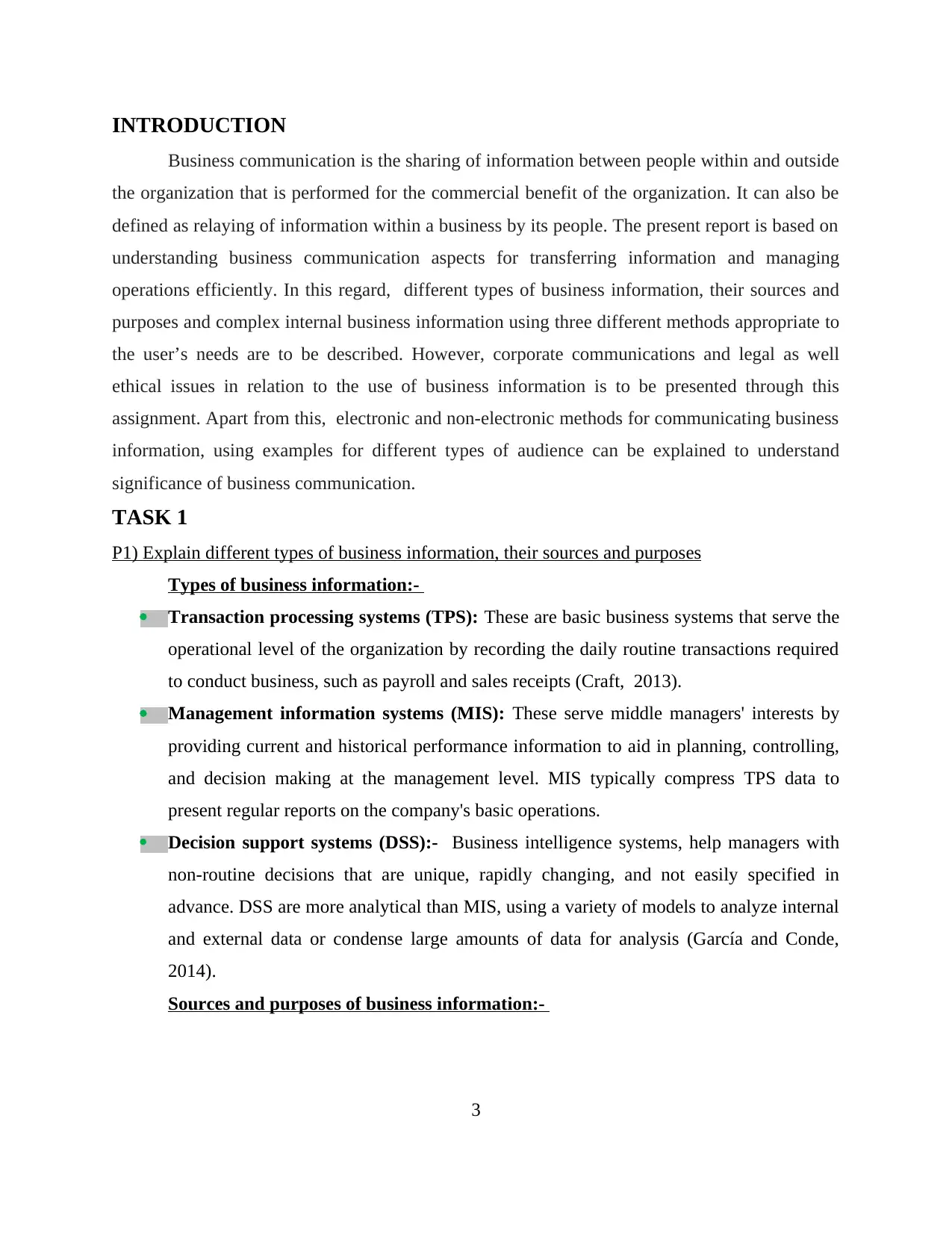
INTRODUCTION
Business communication is the sharing of information between people within and outside
the organization that is performed for the commercial benefit of the organization. It can also be
defined as relaying of information within a business by its people. The present report is based on
understanding business communication aspects for transferring information and managing
operations efficiently. In this regard, different types of business information, their sources and
purposes and complex internal business information using three different methods appropriate to
the user’s needs are to be described. However, corporate communications and legal as well
ethical issues in relation to the use of business information is to be presented through this
assignment. Apart from this, electronic and non-electronic methods for communicating business
information, using examples for different types of audience can be explained to understand
significance of business communication.
TASK 1
P1) Explain different types of business information, their sources and purposes
Types of business information:-
Transaction processing systems (TPS): These are basic business systems that serve the
operational level of the organization by recording the daily routine transactions required
to conduct business, such as payroll and sales receipts (Craft, 2013).
Management information systems (MIS): These serve middle managers' interests by
providing current and historical performance information to aid in planning, controlling,
and decision making at the management level. MIS typically compress TPS data to
present regular reports on the company's basic operations.
Decision support systems (DSS):- Business intelligence systems, help managers with
non-routine decisions that are unique, rapidly changing, and not easily specified in
advance. DSS are more analytical than MIS, using a variety of models to analyze internal
and external data or condense large amounts of data for analysis (García and Conde,
2014).
Sources and purposes of business information:-
3
Business communication is the sharing of information between people within and outside
the organization that is performed for the commercial benefit of the organization. It can also be
defined as relaying of information within a business by its people. The present report is based on
understanding business communication aspects for transferring information and managing
operations efficiently. In this regard, different types of business information, their sources and
purposes and complex internal business information using three different methods appropriate to
the user’s needs are to be described. However, corporate communications and legal as well
ethical issues in relation to the use of business information is to be presented through this
assignment. Apart from this, electronic and non-electronic methods for communicating business
information, using examples for different types of audience can be explained to understand
significance of business communication.
TASK 1
P1) Explain different types of business information, their sources and purposes
Types of business information:-
Transaction processing systems (TPS): These are basic business systems that serve the
operational level of the organization by recording the daily routine transactions required
to conduct business, such as payroll and sales receipts (Craft, 2013).
Management information systems (MIS): These serve middle managers' interests by
providing current and historical performance information to aid in planning, controlling,
and decision making at the management level. MIS typically compress TPS data to
present regular reports on the company's basic operations.
Decision support systems (DSS):- Business intelligence systems, help managers with
non-routine decisions that are unique, rapidly changing, and not easily specified in
advance. DSS are more analytical than MIS, using a variety of models to analyze internal
and external data or condense large amounts of data for analysis (García and Conde,
2014).
Sources and purposes of business information:-
3
⊘ This is a preview!⊘
Do you want full access?
Subscribe today to unlock all pages.

Trusted by 1+ million students worldwide
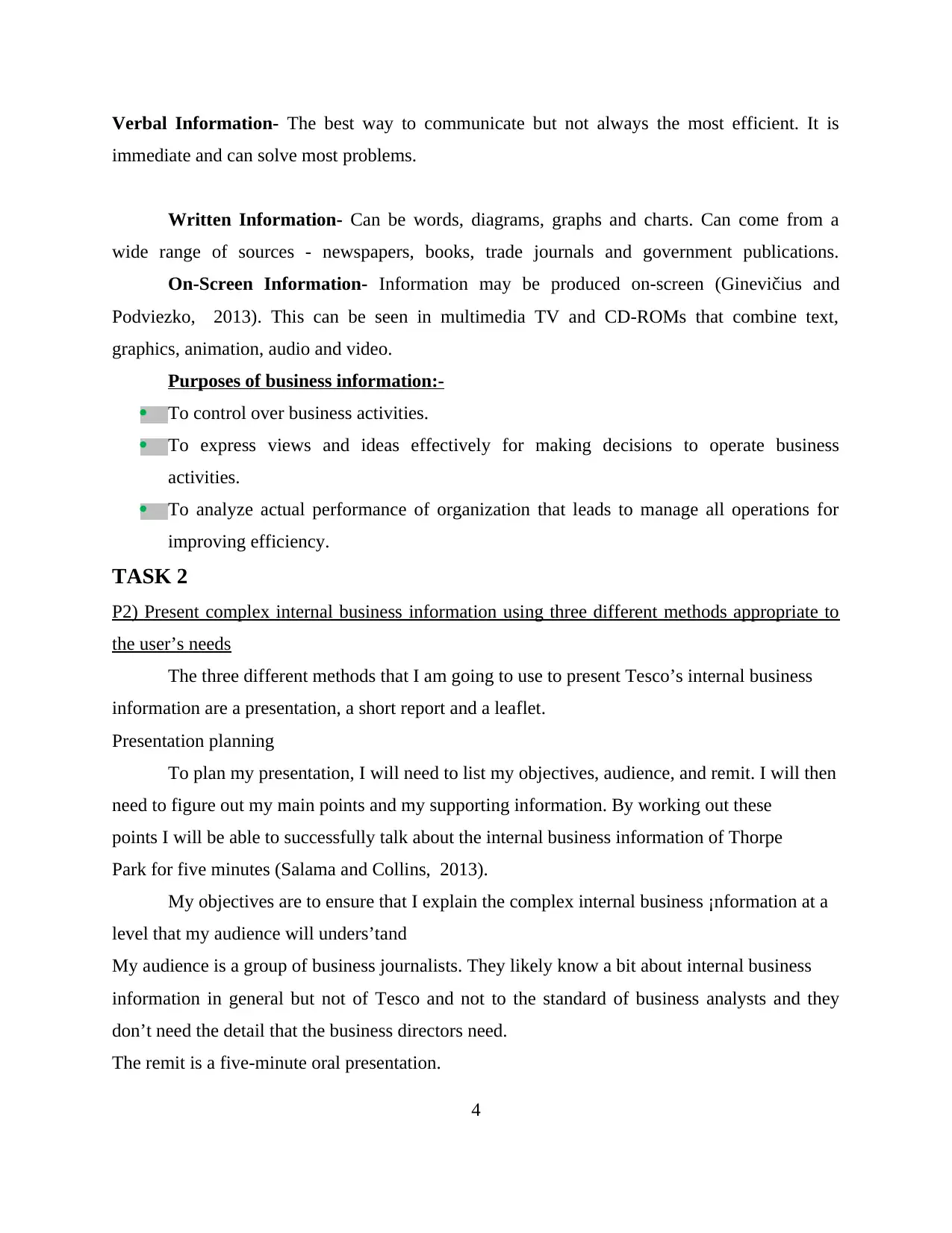
Verbal Information- The best way to communicate but not always the most efficient. It is
immediate and can solve most problems.
Written Information- Can be words, diagrams, graphs and charts. Can come from a
wide range of sources - newspapers, books, trade journals and government publications.
On-Screen Information- Information may be produced on-screen (Ginevičius and
Podviezko, 2013). This can be seen in multimedia TV and CD-ROMs that combine text,
graphics, animation, audio and video.
Purposes of business information:-
To control over business activities.
To express views and ideas effectively for making decisions to operate business
activities.
To analyze actual performance of organization that leads to manage all operations for
improving efficiency.
TASK 2
P2) Present complex internal business information using three different methods appropriate to
the user’s needs
The three different methods that I am going to use to present Tesco’s internal business
information are a presentation, a short report and a leaflet.
Presentation planning
To plan my presentation, I will need to list my objectives, audience, and remit. I will then
need to figure out my main points and my supporting information. By working out these
points I will be able to successfully talk about the internal business information of Thorpe
Park for five minutes (Salama and Collins, 2013).
My objectives are to ensure that I explain the complex internal business ¡nformation at a
level that my audience will unders’tand
My audience is a group of business journalists. They likely know a bit about internal business
information in general but not of Tesco and not to the standard of business analysts and they
don’t need the detail that the business directors need.
The remit is a five-minute oral presentation.
4
immediate and can solve most problems.
Written Information- Can be words, diagrams, graphs and charts. Can come from a
wide range of sources - newspapers, books, trade journals and government publications.
On-Screen Information- Information may be produced on-screen (Ginevičius and
Podviezko, 2013). This can be seen in multimedia TV and CD-ROMs that combine text,
graphics, animation, audio and video.
Purposes of business information:-
To control over business activities.
To express views and ideas effectively for making decisions to operate business
activities.
To analyze actual performance of organization that leads to manage all operations for
improving efficiency.
TASK 2
P2) Present complex internal business information using three different methods appropriate to
the user’s needs
The three different methods that I am going to use to present Tesco’s internal business
information are a presentation, a short report and a leaflet.
Presentation planning
To plan my presentation, I will need to list my objectives, audience, and remit. I will then
need to figure out my main points and my supporting information. By working out these
points I will be able to successfully talk about the internal business information of Thorpe
Park for five minutes (Salama and Collins, 2013).
My objectives are to ensure that I explain the complex internal business ¡nformation at a
level that my audience will unders’tand
My audience is a group of business journalists. They likely know a bit about internal business
information in general but not of Tesco and not to the standard of business analysts and they
don’t need the detail that the business directors need.
The remit is a five-minute oral presentation.
4
Paraphrase This Document
Need a fresh take? Get an instant paraphrase of this document with our AI Paraphraser
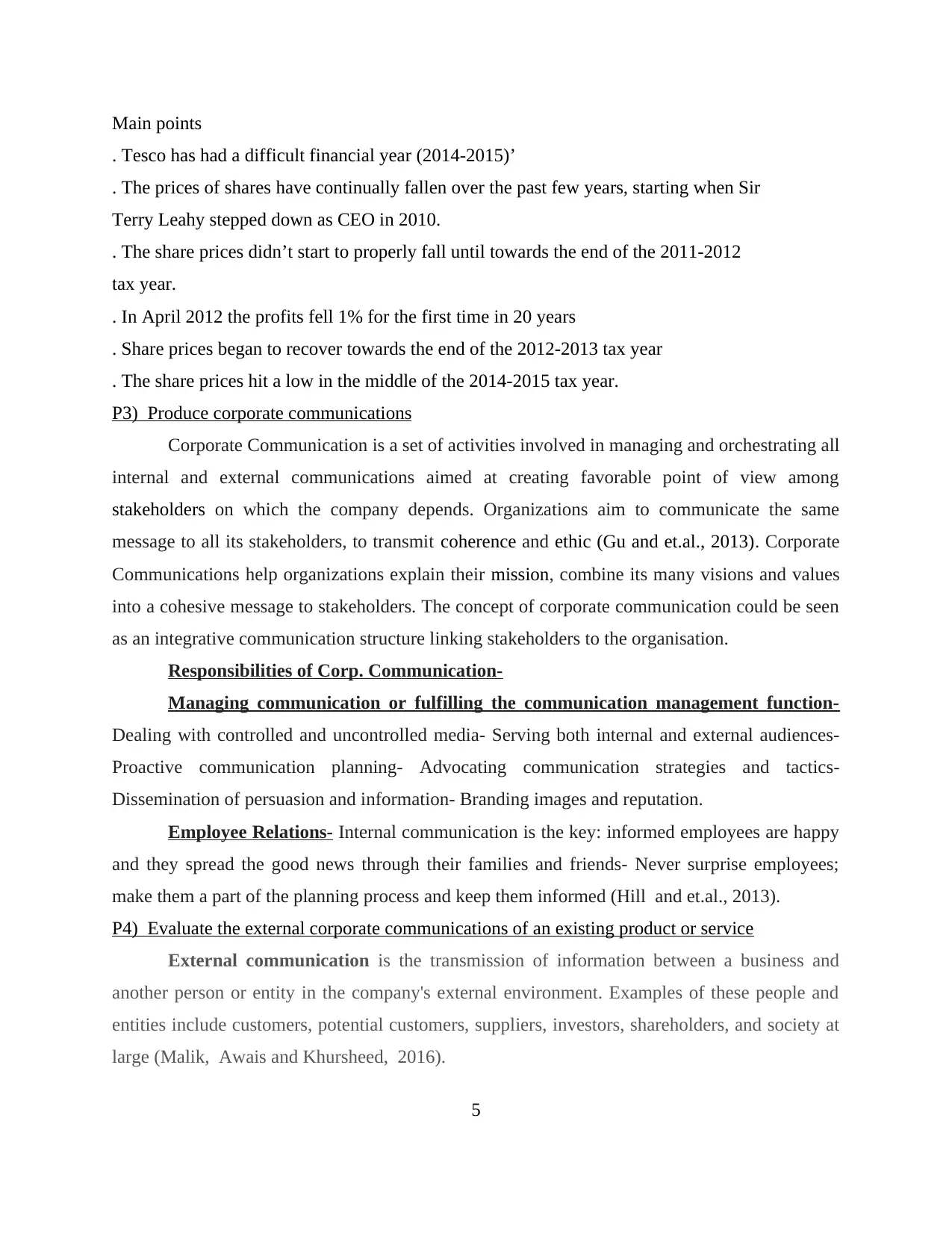
Main points
. Tesco has had a difficult financial year (2014-2015)’
. The prices of shares have continually fallen over the past few years, starting when Sir
Terry Leahy stepped down as CEO in 2010.
. The share prices didn’t start to properly fall until towards the end of the 2011-2012
tax year.
. In April 2012 the profits fell 1% for the first time in 20 years
. Share prices began to recover towards the end of the 2012-2013 tax year
. The share prices hit a low in the middle of the 2014-2015 tax year.
P3) Produce corporate communications
Corporate Communication is a set of activities involved in managing and orchestrating all
internal and external communications aimed at creating favorable point of view among
stakeholders on which the company depends. Organizations aim to communicate the same
message to all its stakeholders, to transmit coherence and ethic (Gu and et.al., 2013). Corporate
Communications help organizations explain their mission, combine its many visions and values
into a cohesive message to stakeholders. The concept of corporate communication could be seen
as an integrative communication structure linking stakeholders to the organisation.
Responsibilities of Corp. Communication-
Managing communication or fulfilling the communication management function-
Dealing with controlled and uncontrolled media- Serving both internal and external audiences-
Proactive communication planning- Advocating communication strategies and tactics-
Dissemination of persuasion and information- Branding images and reputation.
Employee Relations- Internal communication is the key: informed employees are happy
and they spread the good news through their families and friends- Never surprise employees;
make them a part of the planning process and keep them informed (Hill and et.al., 2013).
P4) Evaluate the external corporate communications of an existing product or service
External communication is the transmission of information between a business and
another person or entity in the company's external environment. Examples of these people and
entities include customers, potential customers, suppliers, investors, shareholders, and society at
large (Malik, Awais and Khursheed, 2016).
5
. Tesco has had a difficult financial year (2014-2015)’
. The prices of shares have continually fallen over the past few years, starting when Sir
Terry Leahy stepped down as CEO in 2010.
. The share prices didn’t start to properly fall until towards the end of the 2011-2012
tax year.
. In April 2012 the profits fell 1% for the first time in 20 years
. Share prices began to recover towards the end of the 2012-2013 tax year
. The share prices hit a low in the middle of the 2014-2015 tax year.
P3) Produce corporate communications
Corporate Communication is a set of activities involved in managing and orchestrating all
internal and external communications aimed at creating favorable point of view among
stakeholders on which the company depends. Organizations aim to communicate the same
message to all its stakeholders, to transmit coherence and ethic (Gu and et.al., 2013). Corporate
Communications help organizations explain their mission, combine its many visions and values
into a cohesive message to stakeholders. The concept of corporate communication could be seen
as an integrative communication structure linking stakeholders to the organisation.
Responsibilities of Corp. Communication-
Managing communication or fulfilling the communication management function-
Dealing with controlled and uncontrolled media- Serving both internal and external audiences-
Proactive communication planning- Advocating communication strategies and tactics-
Dissemination of persuasion and information- Branding images and reputation.
Employee Relations- Internal communication is the key: informed employees are happy
and they spread the good news through their families and friends- Never surprise employees;
make them a part of the planning process and keep them informed (Hill and et.al., 2013).
P4) Evaluate the external corporate communications of an existing product or service
External communication is the transmission of information between a business and
another person or entity in the company's external environment. Examples of these people and
entities include customers, potential customers, suppliers, investors, shareholders, and society at
large (Malik, Awais and Khursheed, 2016).
5
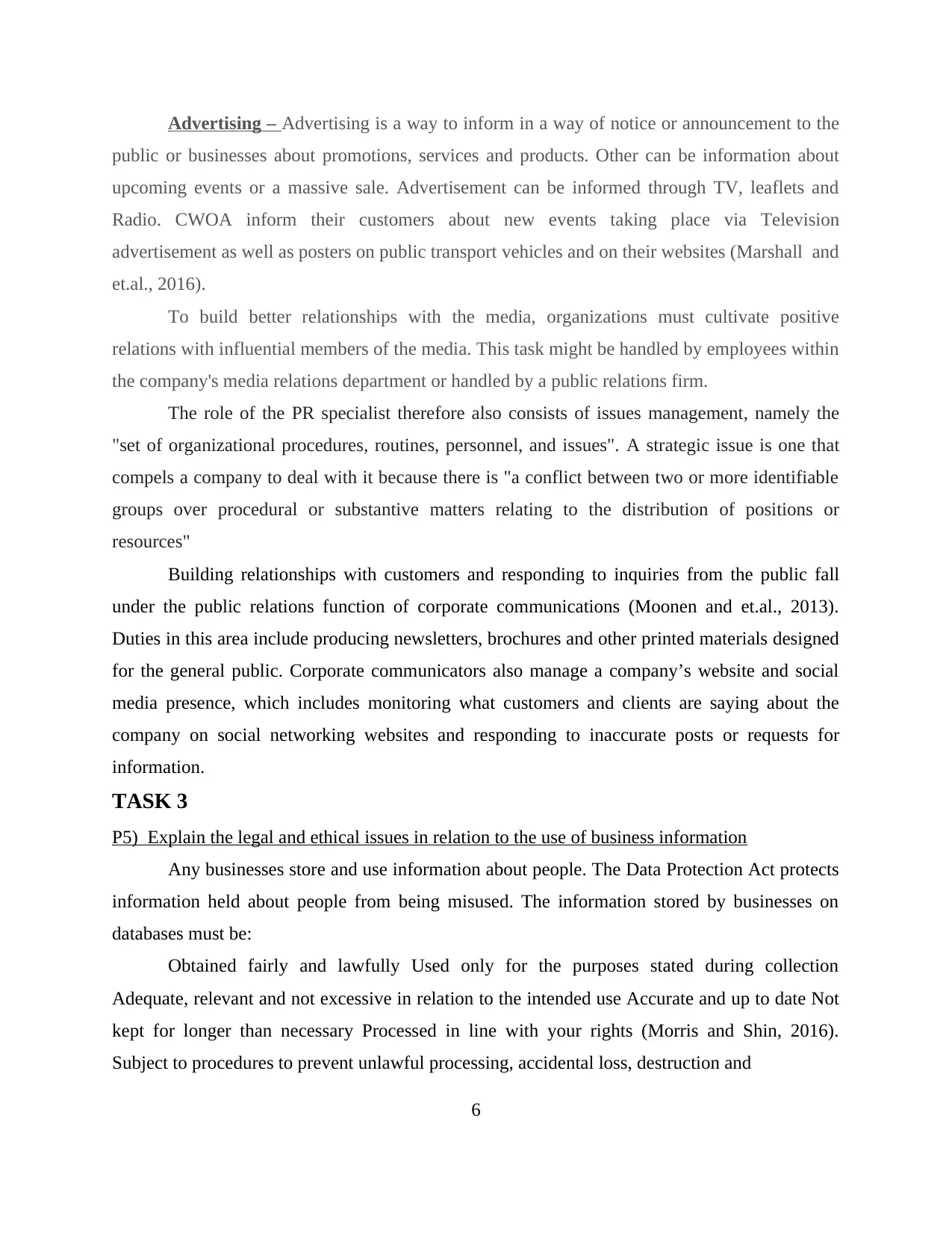
Advertising – Advertising is a way to inform in a way of notice or announcement to the
public or businesses about promotions, services and products. Other can be information about
upcoming events or a massive sale. Advertisement can be informed through TV, leaflets and
Radio. CWOA inform their customers about new events taking place via Television
advertisement as well as posters on public transport vehicles and on their websites (Marshall and
et.al., 2016).
To build better relationships with the media, organizations must cultivate positive
relations with influential members of the media. This task might be handled by employees within
the company's media relations department or handled by a public relations firm.
The role of the PR specialist therefore also consists of issues management, namely the
"set of organizational procedures, routines, personnel, and issues". A strategic issue is one that
compels a company to deal with it because there is "a conflict between two or more identifiable
groups over procedural or substantive matters relating to the distribution of positions or
resources"
Building relationships with customers and responding to inquiries from the public fall
under the public relations function of corporate communications (Moonen and et.al., 2013).
Duties in this area include producing newsletters, brochures and other printed materials designed
for the general public. Corporate communicators also manage a company’s website and social
media presence, which includes monitoring what customers and clients are saying about the
company on social networking websites and responding to inaccurate posts or requests for
information.
TASK 3
P5) Explain the legal and ethical issues in relation to the use of business information
Any businesses store and use information about people. The Data Protection Act protects
information held about people from being misused. The information stored by businesses on
databases must be:
Obtained fairly and lawfully Used only for the purposes stated during collection
Adequate, relevant and not excessive in relation to the intended use Accurate and up to date Not
kept for longer than necessary Processed in line with your rights (Morris and Shin, 2016).
Subject to procedures to prevent unlawful processing, accidental loss, destruction and
6
public or businesses about promotions, services and products. Other can be information about
upcoming events or a massive sale. Advertisement can be informed through TV, leaflets and
Radio. CWOA inform their customers about new events taking place via Television
advertisement as well as posters on public transport vehicles and on their websites (Marshall and
et.al., 2016).
To build better relationships with the media, organizations must cultivate positive
relations with influential members of the media. This task might be handled by employees within
the company's media relations department or handled by a public relations firm.
The role of the PR specialist therefore also consists of issues management, namely the
"set of organizational procedures, routines, personnel, and issues". A strategic issue is one that
compels a company to deal with it because there is "a conflict between two or more identifiable
groups over procedural or substantive matters relating to the distribution of positions or
resources"
Building relationships with customers and responding to inquiries from the public fall
under the public relations function of corporate communications (Moonen and et.al., 2013).
Duties in this area include producing newsletters, brochures and other printed materials designed
for the general public. Corporate communicators also manage a company’s website and social
media presence, which includes monitoring what customers and clients are saying about the
company on social networking websites and responding to inaccurate posts or requests for
information.
TASK 3
P5) Explain the legal and ethical issues in relation to the use of business information
Any businesses store and use information about people. The Data Protection Act protects
information held about people from being misused. The information stored by businesses on
databases must be:
Obtained fairly and lawfully Used only for the purposes stated during collection
Adequate, relevant and not excessive in relation to the intended use Accurate and up to date Not
kept for longer than necessary Processed in line with your rights (Morris and Shin, 2016).
Subject to procedures to prevent unlawful processing, accidental loss, destruction and
6
⊘ This is a preview!⊘
Do you want full access?
Subscribe today to unlock all pages.

Trusted by 1+ million students worldwide
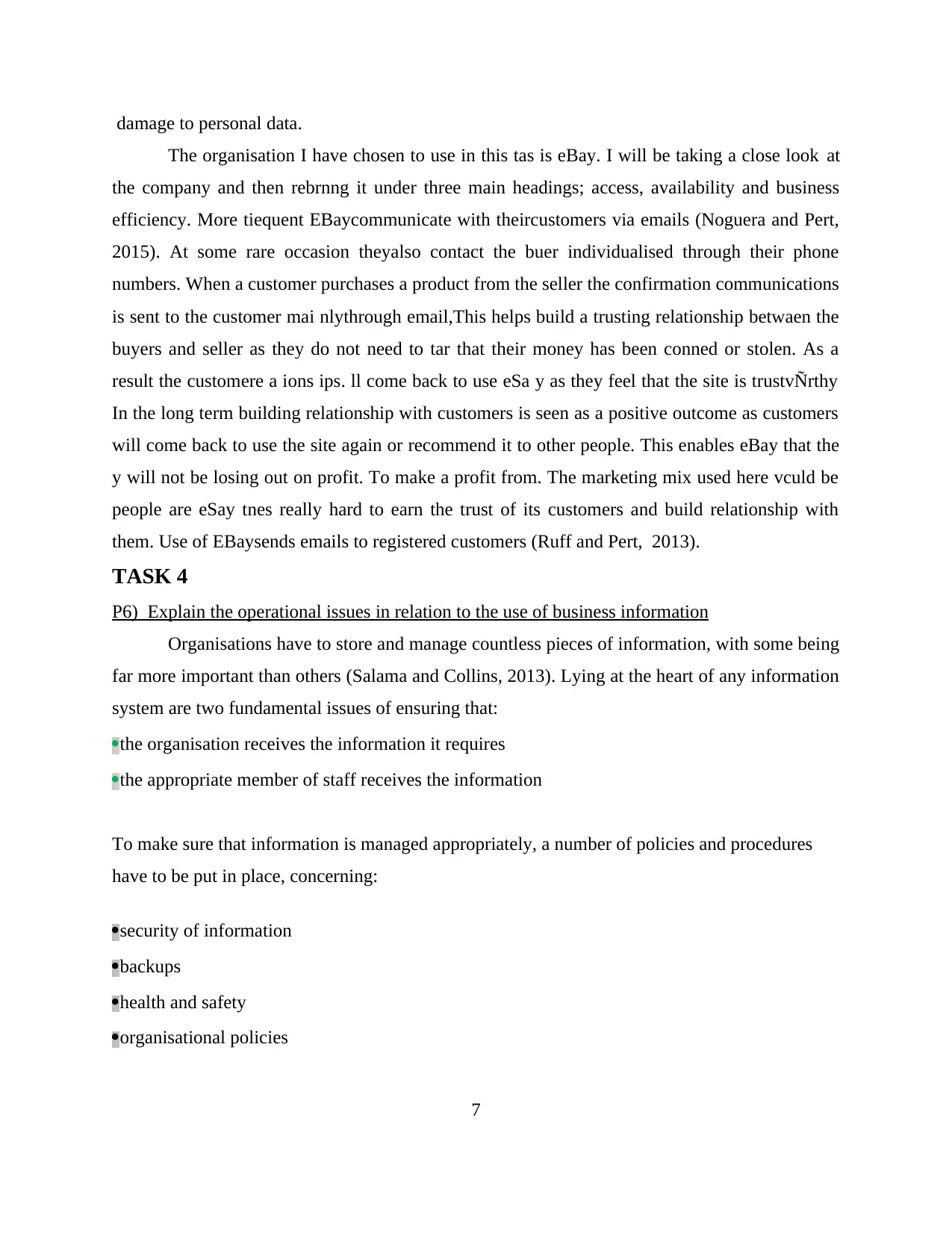
damage to personal data.
The organisation I have chosen to use in this tas is eBay. I will be taking a close look at
the company and then rebrnng it under three main headings; access, availability and business
efficiency. More tiequent EBaycommunicate with theircustomers via emails (Noguera and Pert,
2015). At some rare occasion theyalso contact the buer individualised through their phone
numbers. When a customer purchases a product from the seller the confirmation communications
is sent to the customer mai nlythrough email,This helps build a trusting relationship betwaen the
buyers and seller as they do not need to tar that their money has been conned or stolen. As a
result the customere a ions ips. ll come back to use eSa y as they feel that the site is trustvÑrthy
In the long term building relationship with customers is seen as a positive outcome as customers
will come back to use the site again or recommend it to other people. This enables eBay that the
y will not be losing out on profit. To make a profit from. The marketing mix used here vculd be
people are eSay tnes really hard to earn the trust of its customers and build relationship with
them. Use of EBaysends emails to registered customers (Ruff and Pert, 2013).
TASK 4
P6) Explain the operational issues in relation to the use of business information
Organisations have to store and manage countless pieces of information, with some being
far more important than others (Salama and Collins, 2013). Lying at the heart of any information
system are two fundamental issues of ensuring that:
the organisation receives the information it requires
the appropriate member of staff receives the information
To make sure that information is managed appropriately, a number of policies and procedures
have to be put in place, concerning:
security of information
backups
health and safety
organisational policies
7
The organisation I have chosen to use in this tas is eBay. I will be taking a close look at
the company and then rebrnng it under three main headings; access, availability and business
efficiency. More tiequent EBaycommunicate with theircustomers via emails (Noguera and Pert,
2015). At some rare occasion theyalso contact the buer individualised through their phone
numbers. When a customer purchases a product from the seller the confirmation communications
is sent to the customer mai nlythrough email,This helps build a trusting relationship betwaen the
buyers and seller as they do not need to tar that their money has been conned or stolen. As a
result the customere a ions ips. ll come back to use eSa y as they feel that the site is trustvÑrthy
In the long term building relationship with customers is seen as a positive outcome as customers
will come back to use the site again or recommend it to other people. This enables eBay that the
y will not be losing out on profit. To make a profit from. The marketing mix used here vculd be
people are eSay tnes really hard to earn the trust of its customers and build relationship with
them. Use of EBaysends emails to registered customers (Ruff and Pert, 2013).
TASK 4
P6) Explain the operational issues in relation to the use of business information
Organisations have to store and manage countless pieces of information, with some being
far more important than others (Salama and Collins, 2013). Lying at the heart of any information
system are two fundamental issues of ensuring that:
the organisation receives the information it requires
the appropriate member of staff receives the information
To make sure that information is managed appropriately, a number of policies and procedures
have to be put in place, concerning:
security of information
backups
health and safety
organisational policies
7
Paraphrase This Document
Need a fresh take? Get an instant paraphrase of this document with our AI Paraphraser
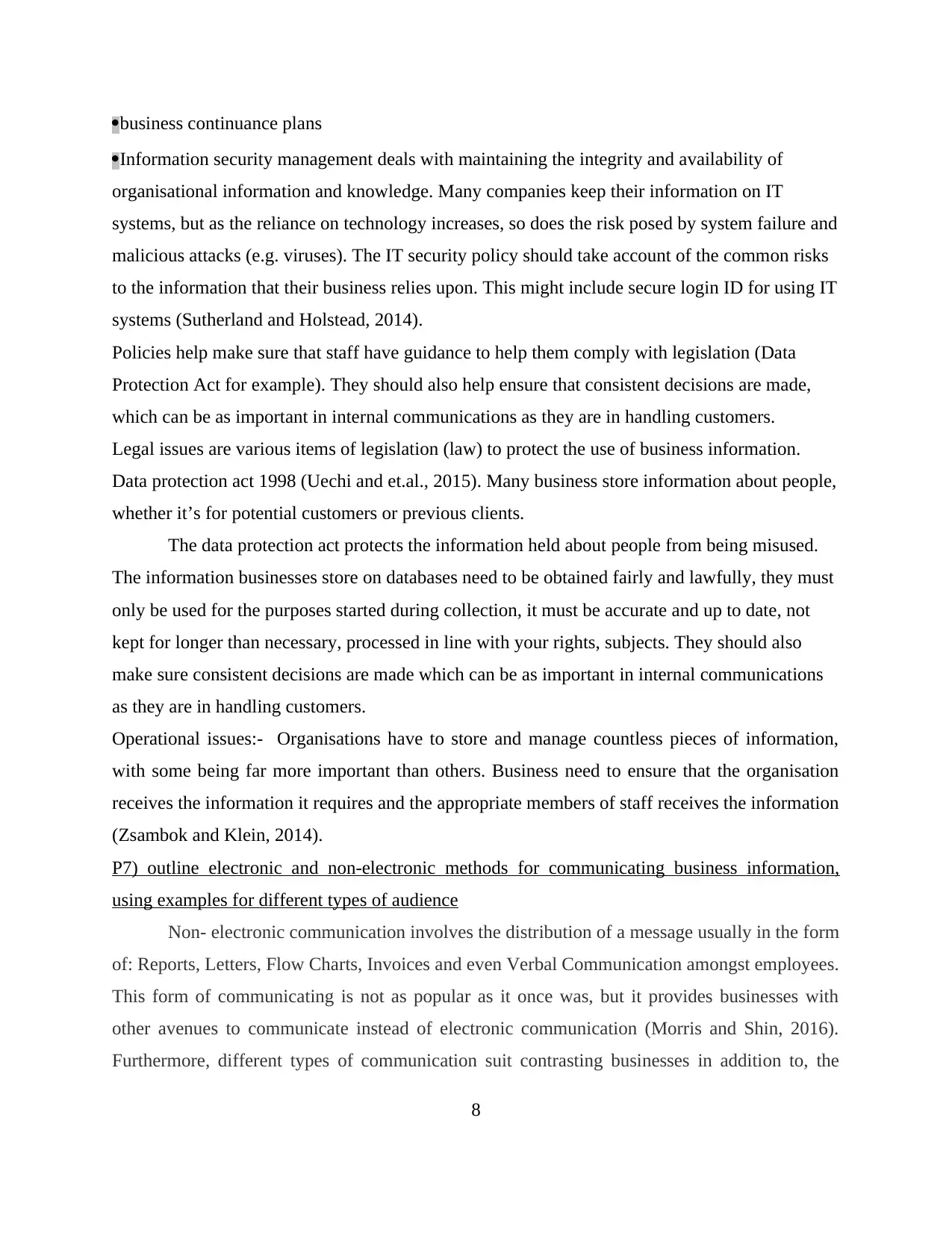
business continuance plans
Information security management deals with maintaining the integrity and availability of
organisational information and knowledge. Many companies keep their information on IT
systems, but as the reliance on technology increases, so does the risk posed by system failure and
malicious attacks (e.g. viruses). The IT security policy should take account of the common risks
to the information that their business relies upon. This might include secure login ID for using IT
systems (Sutherland and Holstead, 2014).
Policies help make sure that staff have guidance to help them comply with legislation (Data
Protection Act for example). They should also help ensure that consistent decisions are made,
which can be as important in internal communications as they are in handling customers.
Legal issues are various items of legislation (law) to protect the use of business information.
Data protection act 1998 (Uechi and et.al., 2015). Many business store information about people,
whether it’s for potential customers or previous clients.
The data protection act protects the information held about people from being misused.
The information businesses store on databases need to be obtained fairly and lawfully, they must
only be used for the purposes started during collection, it must be accurate and up to date, not
kept for longer than necessary, processed in line with your rights, subjects. They should also
make sure consistent decisions are made which can be as important in internal communications
as they are in handling customers.
Operational issues:- Organisations have to store and manage countless pieces of information,
with some being far more important than others. Business need to ensure that the organisation
receives the information it requires and the appropriate members of staff receives the information
(Zsambok and Klein, 2014).
P7) outline electronic and non-electronic methods for communicating business information,
using examples for different types of audience
Non- electronic communication involves the distribution of a message usually in the form
of: Reports, Letters, Flow Charts, Invoices and even Verbal Communication amongst employees.
This form of communicating is not as popular as it once was, but it provides businesses with
other avenues to communicate instead of electronic communication (Morris and Shin, 2016).
Furthermore, different types of communication suit contrasting businesses in addition to, the
8
Information security management deals with maintaining the integrity and availability of
organisational information and knowledge. Many companies keep their information on IT
systems, but as the reliance on technology increases, so does the risk posed by system failure and
malicious attacks (e.g. viruses). The IT security policy should take account of the common risks
to the information that their business relies upon. This might include secure login ID for using IT
systems (Sutherland and Holstead, 2014).
Policies help make sure that staff have guidance to help them comply with legislation (Data
Protection Act for example). They should also help ensure that consistent decisions are made,
which can be as important in internal communications as they are in handling customers.
Legal issues are various items of legislation (law) to protect the use of business information.
Data protection act 1998 (Uechi and et.al., 2015). Many business store information about people,
whether it’s for potential customers or previous clients.
The data protection act protects the information held about people from being misused.
The information businesses store on databases need to be obtained fairly and lawfully, they must
only be used for the purposes started during collection, it must be accurate and up to date, not
kept for longer than necessary, processed in line with your rights, subjects. They should also
make sure consistent decisions are made which can be as important in internal communications
as they are in handling customers.
Operational issues:- Organisations have to store and manage countless pieces of information,
with some being far more important than others. Business need to ensure that the organisation
receives the information it requires and the appropriate members of staff receives the information
(Zsambok and Klein, 2014).
P7) outline electronic and non-electronic methods for communicating business information,
using examples for different types of audience
Non- electronic communication involves the distribution of a message usually in the form
of: Reports, Letters, Flow Charts, Invoices and even Verbal Communication amongst employees.
This form of communicating is not as popular as it once was, but it provides businesses with
other avenues to communicate instead of electronic communication (Morris and Shin, 2016).
Furthermore, different types of communication suit contrasting businesses in addition to, the
8
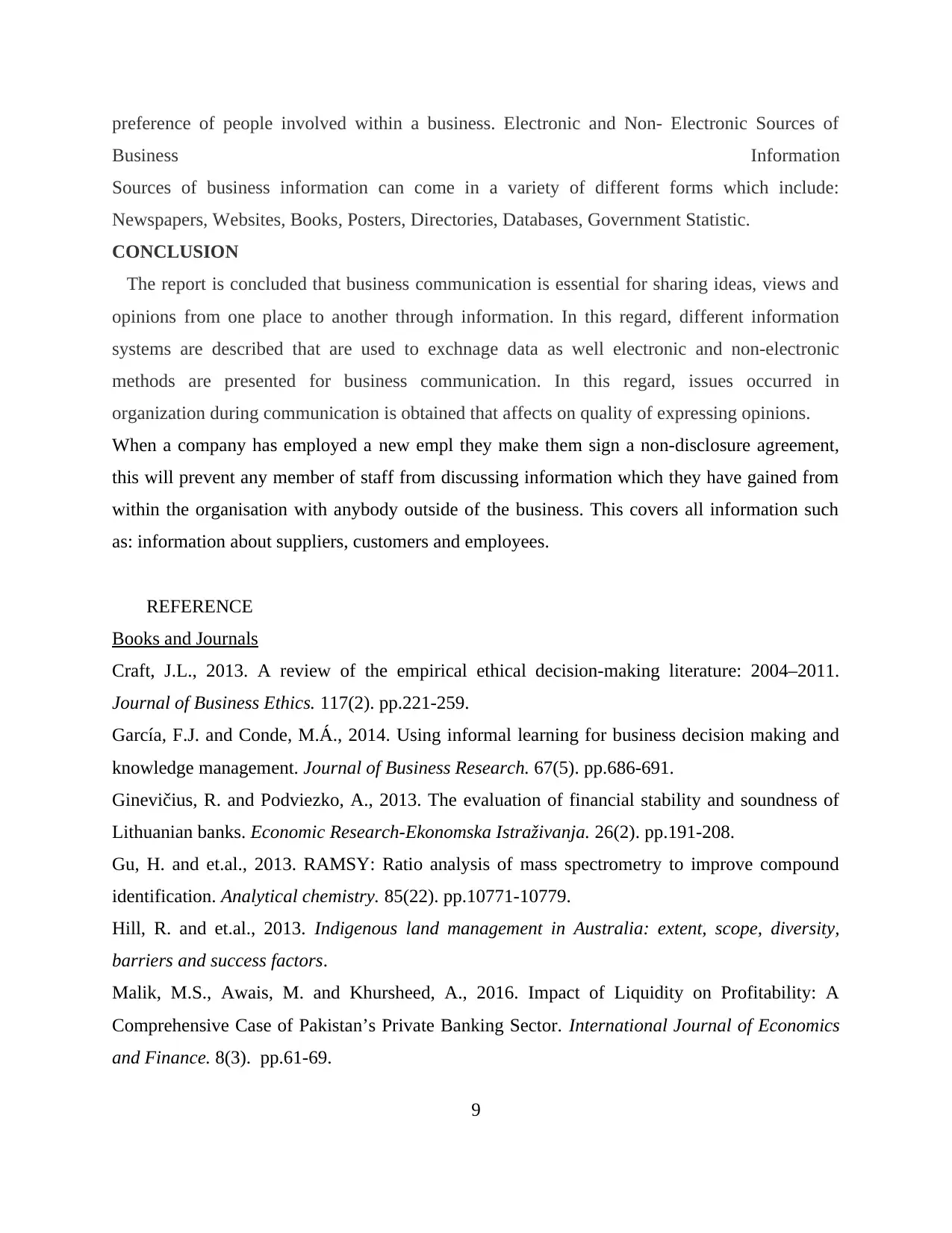
preference of people involved within a business. Electronic and Non- Electronic Sources of
Business Information
Sources of business information can come in a variety of different forms which include:
Newspapers, Websites, Books, Posters, Directories, Databases, Government Statistic.
CONCLUSION
ioThe report is concluded that business communication is essential for sharing ideas, views and
opinions from one place to another through information. In this regard, different information
systems are described that are used to exchnage data as well electronic and non-electronic
methods are presented for business communication. In this regard, issues occurred in
organization during communication is obtained that affects on quality of expressing opinions.
When a company has employed a new empl they make them sign a non-disclosure agreement,
this will prevent any member of staff from discussing information which they have gained from
within the organisation with anybody outside of the business. This covers all information such
as: information about suppliers, customers and employees.
When a company has employed a new employee they make them
signREFERENCE
Books and Journals
Craft, J.L., 2013. A review of the empirical ethical decision-making literature: 2004–2011.
Journal of Business Ethics. 117(2). pp.221-259.
García, F.J. and Conde, M.Á., 2014. Using informal learning for business decision making and
knowledge management. Journal of Business Research. 67(5). pp.686-691.
Ginevičius, R. and Podviezko, A., 2013. The evaluation of financial stability and soundness of
Lithuanian banks. Economic Research-Ekonomska Istraživanja. 26(2). pp.191-208.
Gu, H. and et.al., 2013. RAMSY: Ratio analysis of mass spectrometry to improve compound
identification. Analytical chemistry. 85(22). pp.10771-10779.
Hill, R. and et.al., 2013. Indigenous land management in Australia: extent, scope, diversity,
barriers and success factors.
Malik, M.S., Awais, M. and Khursheed, A., 2016. Impact of Liquidity on Profitability: A
Comprehensive Case of Pakistan’s Private Banking Sector. International Journal of Economics
and Finance. 8(3). pp.61-69.
9
Business Information
Sources of business information can come in a variety of different forms which include:
Newspapers, Websites, Books, Posters, Directories, Databases, Government Statistic.
CONCLUSION
ioThe report is concluded that business communication is essential for sharing ideas, views and
opinions from one place to another through information. In this regard, different information
systems are described that are used to exchnage data as well electronic and non-electronic
methods are presented for business communication. In this regard, issues occurred in
organization during communication is obtained that affects on quality of expressing opinions.
When a company has employed a new empl they make them sign a non-disclosure agreement,
this will prevent any member of staff from discussing information which they have gained from
within the organisation with anybody outside of the business. This covers all information such
as: information about suppliers, customers and employees.
When a company has employed a new employee they make them
signREFERENCE
Books and Journals
Craft, J.L., 2013. A review of the empirical ethical decision-making literature: 2004–2011.
Journal of Business Ethics. 117(2). pp.221-259.
García, F.J. and Conde, M.Á., 2014. Using informal learning for business decision making and
knowledge management. Journal of Business Research. 67(5). pp.686-691.
Ginevičius, R. and Podviezko, A., 2013. The evaluation of financial stability and soundness of
Lithuanian banks. Economic Research-Ekonomska Istraživanja. 26(2). pp.191-208.
Gu, H. and et.al., 2013. RAMSY: Ratio analysis of mass spectrometry to improve compound
identification. Analytical chemistry. 85(22). pp.10771-10779.
Hill, R. and et.al., 2013. Indigenous land management in Australia: extent, scope, diversity,
barriers and success factors.
Malik, M.S., Awais, M. and Khursheed, A., 2016. Impact of Liquidity on Profitability: A
Comprehensive Case of Pakistan’s Private Banking Sector. International Journal of Economics
and Finance. 8(3). pp.61-69.
9
⊘ This is a preview!⊘
Do you want full access?
Subscribe today to unlock all pages.

Trusted by 1+ million students worldwide
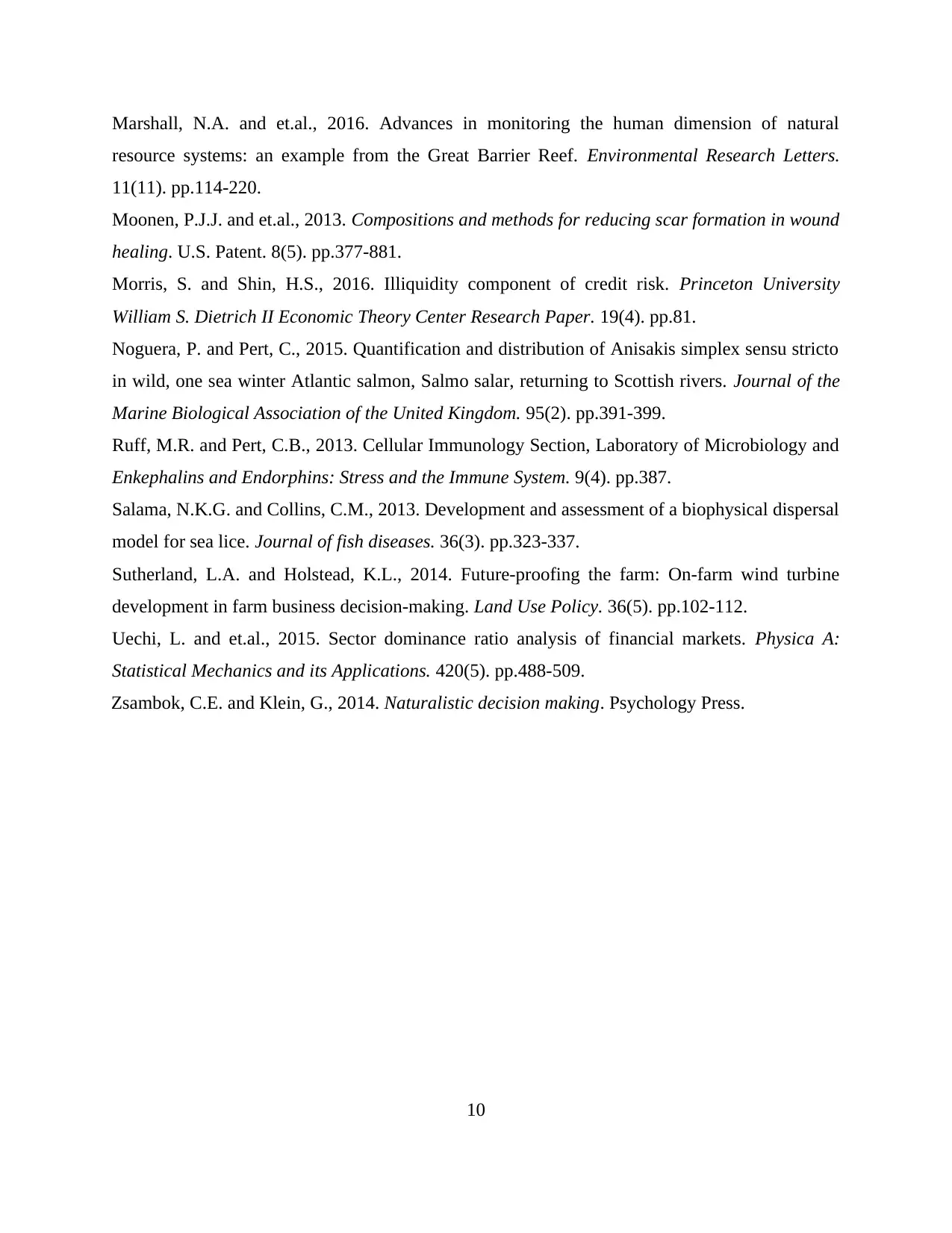
Marshall, N.A. and et.al., 2016. Advances in monitoring the human dimension of natural
resource systems: an example from the Great Barrier Reef. Environmental Research Letters.
11(11). pp.114-220.
Moonen, P.J.J. and et.al., 2013. Compositions and methods for reducing scar formation in wound
healing. U.S. Patent. 8(5). pp.377-881.
Morris, S. and Shin, H.S., 2016. Illiquidity component of credit risk. Princeton University
William S. Dietrich II Economic Theory Center Research Paper. 19(4). pp.81.
Noguera, P. and Pert, C., 2015. Quantification and distribution of Anisakis simplex sensu stricto
in wild, one sea winter Atlantic salmon, Salmo salar, returning to Scottish rivers. Journal of the
Marine Biological Association of the United Kingdom. 95(2). pp.391-399.
Ruff, M.R. and Pert, C.B., 2013. Cellular Immunology Section, Laboratory of Microbiology and
Enkephalins and Endorphins: Stress and the Immune System. 9(4). pp.387.
Salama, N.K.G. and Collins, C.M., 2013. Development and assessment of a biophysical dispersal
model for sea lice. Journal of fish diseases. 36(3). pp.323-337.
Sutherland, L.A. and Holstead, K.L., 2014. Future-proofing the farm: On-farm wind turbine
development in farm business decision-making. Land Use Policy. 36(5). pp.102-112.
Uechi, L. and et.al., 2015. Sector dominance ratio analysis of financial markets. Physica A:
Statistical Mechanics and its Applications. 420(5). pp.488-509.
Zsambok, C.E. and Klein, G., 2014. Naturalistic decision making. Psychology Press.
10
resource systems: an example from the Great Barrier Reef. Environmental Research Letters.
11(11). pp.114-220.
Moonen, P.J.J. and et.al., 2013. Compositions and methods for reducing scar formation in wound
healing. U.S. Patent. 8(5). pp.377-881.
Morris, S. and Shin, H.S., 2016. Illiquidity component of credit risk. Princeton University
William S. Dietrich II Economic Theory Center Research Paper. 19(4). pp.81.
Noguera, P. and Pert, C., 2015. Quantification and distribution of Anisakis simplex sensu stricto
in wild, one sea winter Atlantic salmon, Salmo salar, returning to Scottish rivers. Journal of the
Marine Biological Association of the United Kingdom. 95(2). pp.391-399.
Ruff, M.R. and Pert, C.B., 2013. Cellular Immunology Section, Laboratory of Microbiology and
Enkephalins and Endorphins: Stress and the Immune System. 9(4). pp.387.
Salama, N.K.G. and Collins, C.M., 2013. Development and assessment of a biophysical dispersal
model for sea lice. Journal of fish diseases. 36(3). pp.323-337.
Sutherland, L.A. and Holstead, K.L., 2014. Future-proofing the farm: On-farm wind turbine
development in farm business decision-making. Land Use Policy. 36(5). pp.102-112.
Uechi, L. and et.al., 2015. Sector dominance ratio analysis of financial markets. Physica A:
Statistical Mechanics and its Applications. 420(5). pp.488-509.
Zsambok, C.E. and Klein, G., 2014. Naturalistic decision making. Psychology Press.
10
1 out of 10
Related Documents
Your All-in-One AI-Powered Toolkit for Academic Success.
+13062052269
info@desklib.com
Available 24*7 on WhatsApp / Email
![[object Object]](/_next/static/media/star-bottom.7253800d.svg)
Unlock your academic potential
Copyright © 2020–2025 A2Z Services. All Rights Reserved. Developed and managed by ZUCOL.





